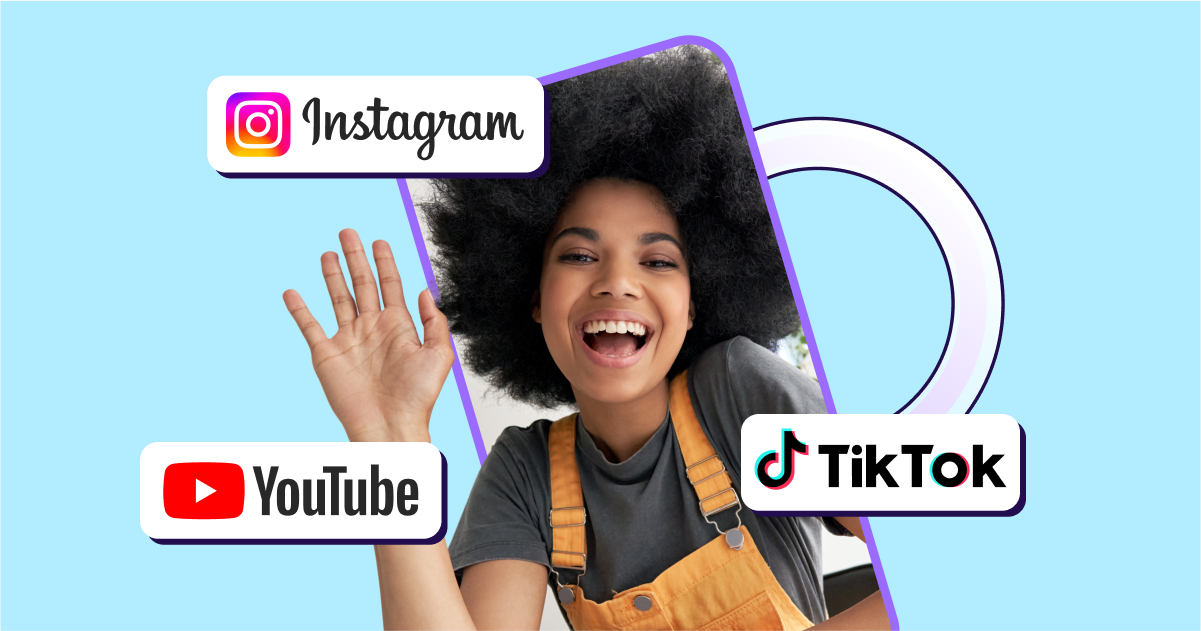
How to Use AI to Boost Your ASO
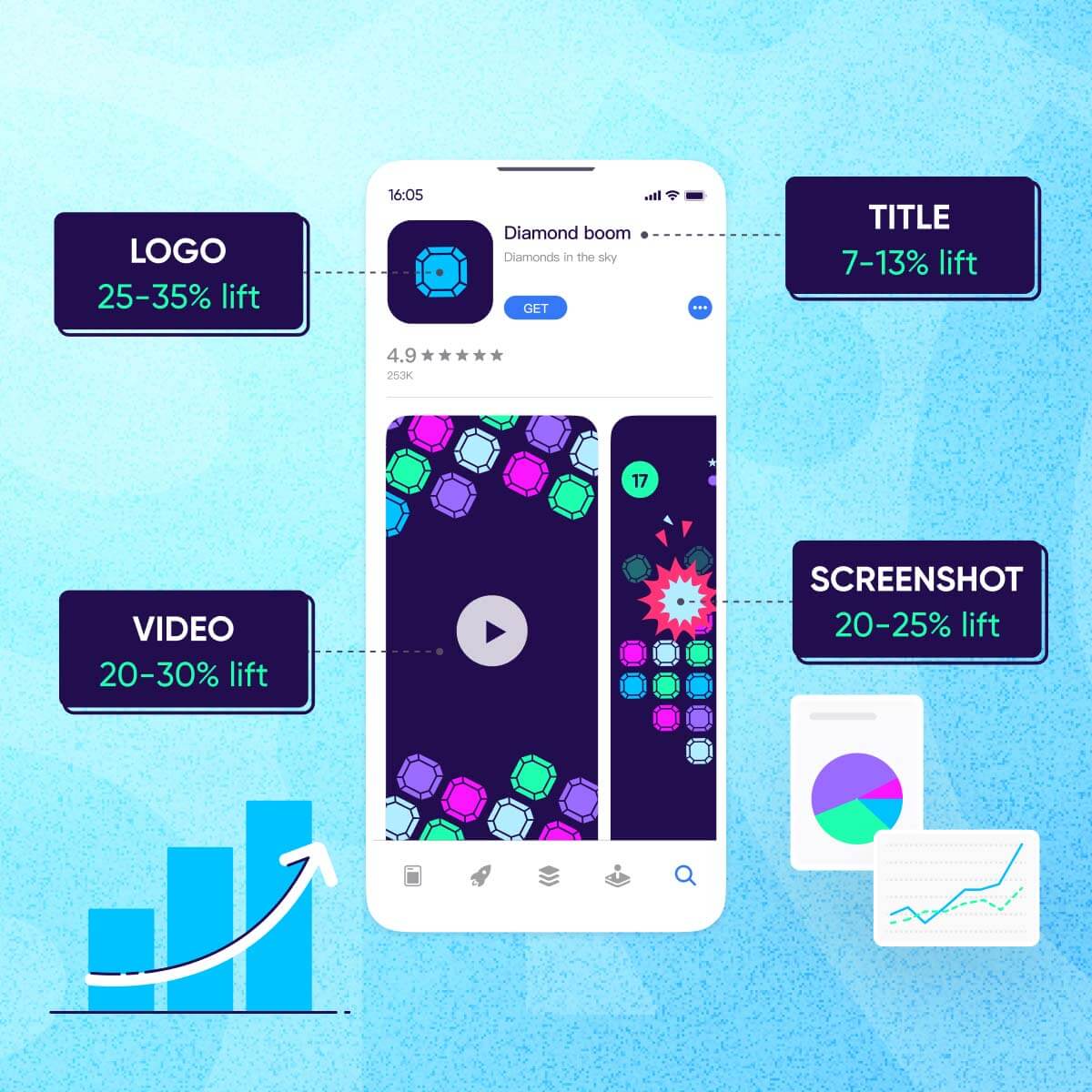
The integration of AI in App Store Optimization (ASO) marks a significant change, introducing advanced tools to make your app more discoverable and boost engagement.
In this blog, we’ll explore how AI is redefining traditional ASO practices, from keyword optimization to understanding user behavior patterns. Beyond identifying the opportunities AI presents, we’ll also tackle the challenges and misconceptions that come with it, helping you prepare for both the potential rewards and pitfalls of using AI in ASO.
The role of AI in ASO
The integration of AI into ASO is transforming the way app developers and marketers optimize their apps for better visibility and engagement. By automating and improving tasks across various aspects of ASO, AI is setting a new standard for efficiency and effectiveness in in-app marketing strategies. Let’s take a look at how:
1. Providing data-driven insights
AI helps transform raw data into actionable insights. For ASO, this means analyzing performance metrics from across the app stores to identify what works and what doesn’t. AI algorithms can quickly process variations in user engagement and app performance, providing a granular analysis that helps in fine-tuning marketing strategies.
Here are some key ways you can use AI to get data-driven marketing insights in ASO:
- Performance analysis: AI excels in identifying app performance metrics, from download figures and user retention rates to ratings and review sentiments. This analysis sheds light on an app’s strengths and weaknesses, guiding developers on where improvements are needed.
- User engagement insights: By evaluating how users interact with apps, AI identifies patterns that contribute to higher engagement levels.
- Metadata optimization: AI-powered tools analyze the effectiveness of app titles, descriptions, keywords, and visuals, comparing them against top-performing apps in similar categories.
- Competitive analysis: AI algorithms can monitor competitors’ performance, offering a clear perspective on market dynamics. Understanding what makes competing apps successful helps you craft strategies that capitalize on market gaps or leverage emerging trends.
2. Identifying high-value keywords
Using AI, developers can identify which keywords are likely to drive the most traffic to their app page. AI tools analyze search frequency, competitiveness, and relevance to suggest high-value keywords.
When conducting app store keyword research, relying on general AI tools may not provide the specific insights you need due to their broad focus. Advanced AI-powered tools become invaluable here, providing more accurate and effective insights to developers.
For example, you can leverage AppTweak’s AI-generated keyword list to jumpstart your analysis with keywords tailored to your app or game, as well as for competitor apps. With AI-generated keyword clusters – groups of keywords that Apple or Google identifies as closely related to your input – you can also uncover new keyword opportunities that are potentially less competitive than their seed keywords.
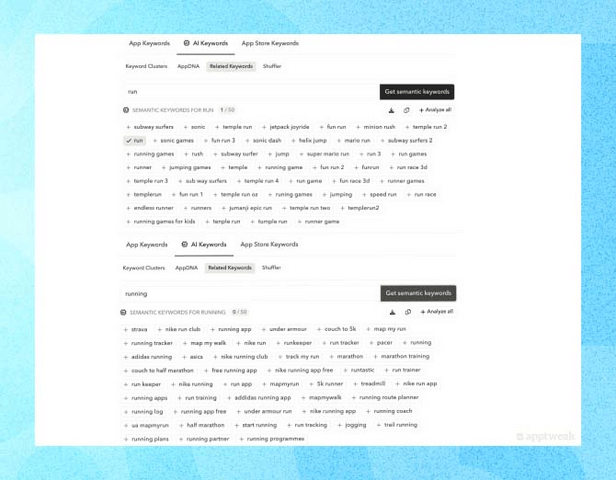
3. Optimizing app/game marketing efforts with AI
Google Play’s integration of AI-powered features marks a significant advancement in ASO strategies for game developers. By displaying AI-generated FAQs directly within game listings, Google Play enhances user engagement and provides crucial information at a glance. This not only enriches the user experience but also helps in decision-making and boosts download rates.
Also, Google’s introduction of immersive in-game ads and exclusive offers for Play Pass subscribers and Play Points members demonstrates a nuanced understanding of how you can use AI to create targeted marketing opportunities.
How to incorporate AI in ASO: Practical examples
Integrating AI into ASO makes a lot of sense on paper – but what about the real-world benefits?
AI tools in the ASO landscape are already making tangible waves, offering developers and marketers a suite of features to enhance their strategies. Let’s explore how.
1. Optimizing text metadata with AI
Traditional keyword research methods often miss the mark by not adapting to changing user interests or identifying emerging trends.
AI is crucial in addressing the gap in keyword research for app developers and marketers. It revolutionizes how text metadata – like app titles, descriptions, and keyword fields – is created. By providing relevant and high-performing keywords, AI ensures apps are more visible and rank higher in app store searches.
Sophisticated AI tools go beyond the standard ones like ChatGPT, enabling you to optimize your app metadata and ensure that every piece of content is precisely optimized for maximum impact. For example, with AppTweak’s homegrown Atlas AI, it’s easy to not only identify current popular keywords but also predict future trends. Content creators and marketers can then incorporate keywords that are poised to gain popularity, and ensure their content remains relevant and highly visible over time.
AI tools like AppTweak can further recommend the inclusion of certain keywords in titles and meta descriptions, as well as provide tailored insights to accommodate regional and linguistic variations.
While AI can help identify and integrate keywords into your app’s metadata for better visibility, remember the human element. Your app’s title, description, and other metadata should not only include relevant keywords but also engage and appeal to potential users.
2. AI in app store localization
AI is reshaping the landscape of app store localization, offering developers and marketers innovative solutions to improve accuracy, speed up processes, and ensure cultural relevance. The integration of AI in localization strategies not only streamlines content adaptation across different languages, but also tailors this content to meet the specific cultural nuances of the target audience.
Google’s foray into AI-powered translation is perhaps the most recognizable example. Google Translate uses Neural Machine Translation (NMT) technology to provide translations that are not just word-for-word, but contextually accurate and culturally appropriate. This represents a significant leap from traditional translation methods, ensuring that web content and apps resonate with users worldwide by maintaining the intended meaning and tone.
Mobile game localization with AI
Going beyond written translation, some AI models can generate new audio based on the translated text and even optimize visual elements in mobile games to align with the cultural contexts of the target audience. This includes modifying the appearance of characters and settings to be more culturally relevant, ensuring an immersive experience for players from different regions.
For example, the localization efforts for the RPG game The Witcher 3: Wild Hunt make the game feel originally developed for various markets, rather than merely adapted. The game developers used AI-driven tools to adapt the game’s vast narrative and dialogues, ensuring cultural relevance and linguistic accuracy across different languages. Given the role-playing genre of The Witcher 3, the scope of translation work, including voiceovers, was extensive.
However, the role of human translators, particularly native translators, remains critical in localization. Despite AI’s advancements, it sometimes misses the mark on cultural nuances and may deliver less than precise translations. These inaccuracies highlight the need for human intervention to ensure that the game’s content is not only linguistically accurate, but also culturally appropriate and resonant with the target audience. The goal is to avoid any misinterpretations or cultural insensitivities that could negatively impact the user’s experience.
3. Using AI to refine app store creatives
Beyond text, AI can also help optimize the visual elements of your app store listing. AI revolutionizes this process by analyzing millions of images or videos quickly. It categorizes them by trends such as mood, color, or objects, streamlining the ideation phase.
This not only speeds up content creation but also infuses your strategy with data-backed decisions, ensuring your content is more aligned with audience preferences and boosting engagement. It can fundamentally transform how developers approach app or game creatives to maximize user engagement and conversion rates.
- Create app icons using AI: AI tools such as Midjourney simplify the creation of app icons. By submitting clear, specific prompts, you can easily edit current icons or start new designs. This helps you design an app icon that not only catches the eye but also matches your brand identity closely.
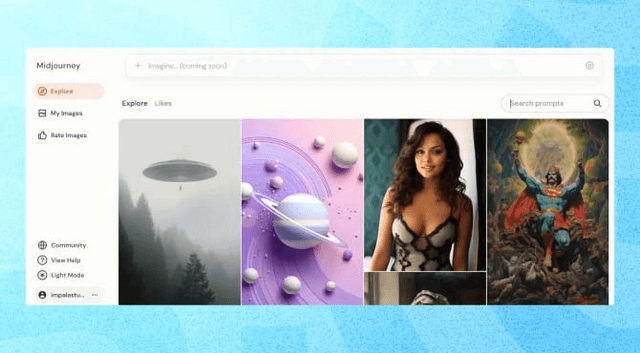
- Analyze visual elements: AI algorithms equipped with image and video recognition capabilities can analyze the performance of visual elements in real-time, identifying patterns and trends that correlate with user engagement. For instance, AI can discern which colors, shapes, or themes in app icons and screenshots are more likely to catch the attention of potential users.
- Automate A/B testing: Other AI tools revolutionize creative optimization in the gaming industry. For example, by automating A/B testing, PressPlay allows game developers, like Wildlife Studios, to efficiently test different creative options for their games. This means they can quickly find out which images, videos, or metadata work best to attract users. Using AI to automate the creation, deployment, and analysis of these tests saves a lot of time and effort, making the process much more data-driven.
- Personalize content delivery: AI enables developers to personalize creatives displayed to users based on their preferences, behavior, and previous interactions with the app. This level of personalization ensures that users see visuals that are most appealing and relevant to them, increasing the likelihood of engagement and conversion.
For example, the popular streaming app Netflix uses AI to personalize thumbnails shown to users. Using AI, the app analyzes individual viewing habits to determine which type of imagery a user is most likely to respond to, and then adjusts the thumbnails of movies and series to match these preferences.
- Optimize gameplay and boost player engagement: The use of AI by Rovio shows how game developers can use machine learning to significantly improve visual elements and gameplay mechanics. AI’s ability to analyze and optimize game scenes in real-time gives players high-resolution output with improved detail and smoother textures. This not only elevates the gaming experience but makes it stand out in the competitive app stores, attracting more downloads and increasing user retention rates.
Understanding the limitations
While generative AI is an effective tool for content generation, it’s important to recognize its limits — namely, that it falls short when it comes to capturing the emotional depth and cultural nuances that human creators excel at.
Creativity is all about connecting with people on an emotional level. If we lean too much on AI, we might lose that human touch that makes content resonate with audiences. For app developers and marketers, it’s wise to use generative AI for brainstorming and developing initial ideas. However, final content creation should integrate human insight to ensure it resonates on a deeper level, improving customer satisfaction.
Extracting value from user reviews
AI can also boost your ASO efforts by extracting valuable insights from user reviews. Through the analysis of word frequencies and semantics, AI can uncover key topics within reviews without human intervention. This helps identify and score specific topics found in user feedback, so you can systematically monitor their evolution over time.
Understanding sentiment analysis
Sentiment analysis leverages AI to categorize user feedback into distinct sentiments – positive, neutral, or negative – and further identifies specific themes or issues mentioned in the reviews. This provides a comprehensive overview of user satisfaction and areas requiring attention, which helps guide product development and marketing strategies.
Facing challenges with ChatGPT’s broad approach in extracting meaningful insights from user feedback, AppTweak’s data science team shifted to a more focused strategy. We adopted unsupervised machine learning techniques, aiming to identify key topics and their relevance within user reviews.
This method allowed us to identify word patterns and meanings within user reviews. We were able to find specific topics that frequently arise in user feedback, allowing developers to track how these topics change over time.
Take Netflix, for example. After the streaming platform removed The Vampire Diaries series from its content library, we saw a visible increase in 1-star and 2-star reviews on the App Store. Our analysis highlighted the frequent mention of the series’ removal as a predominant factor driving user dissatisfaction.
Developers could now use these insights to take corrective actions – whether reintroducing popular content, adjusting content strategies, or communicating more effectively with users about content changes.
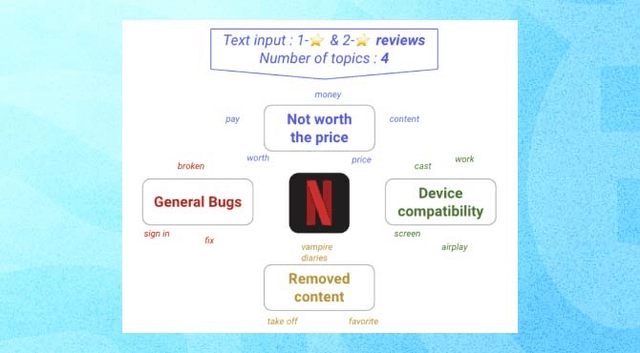
The bottom line
AI teaming up with ASO is more of a partnership than a takeover. It’s about combining AI’s power with human creativity and insight. This way, we get an ASO strategy that’s smart, efficient, and really connects with users.
The future of AI in ASO isn’t just crunching numbers – it’s about really getting to know what users want and creating experiences that hit the mark. Successful apps and games will be those that not only get discovered but also truly meet users’ needs and desires.



